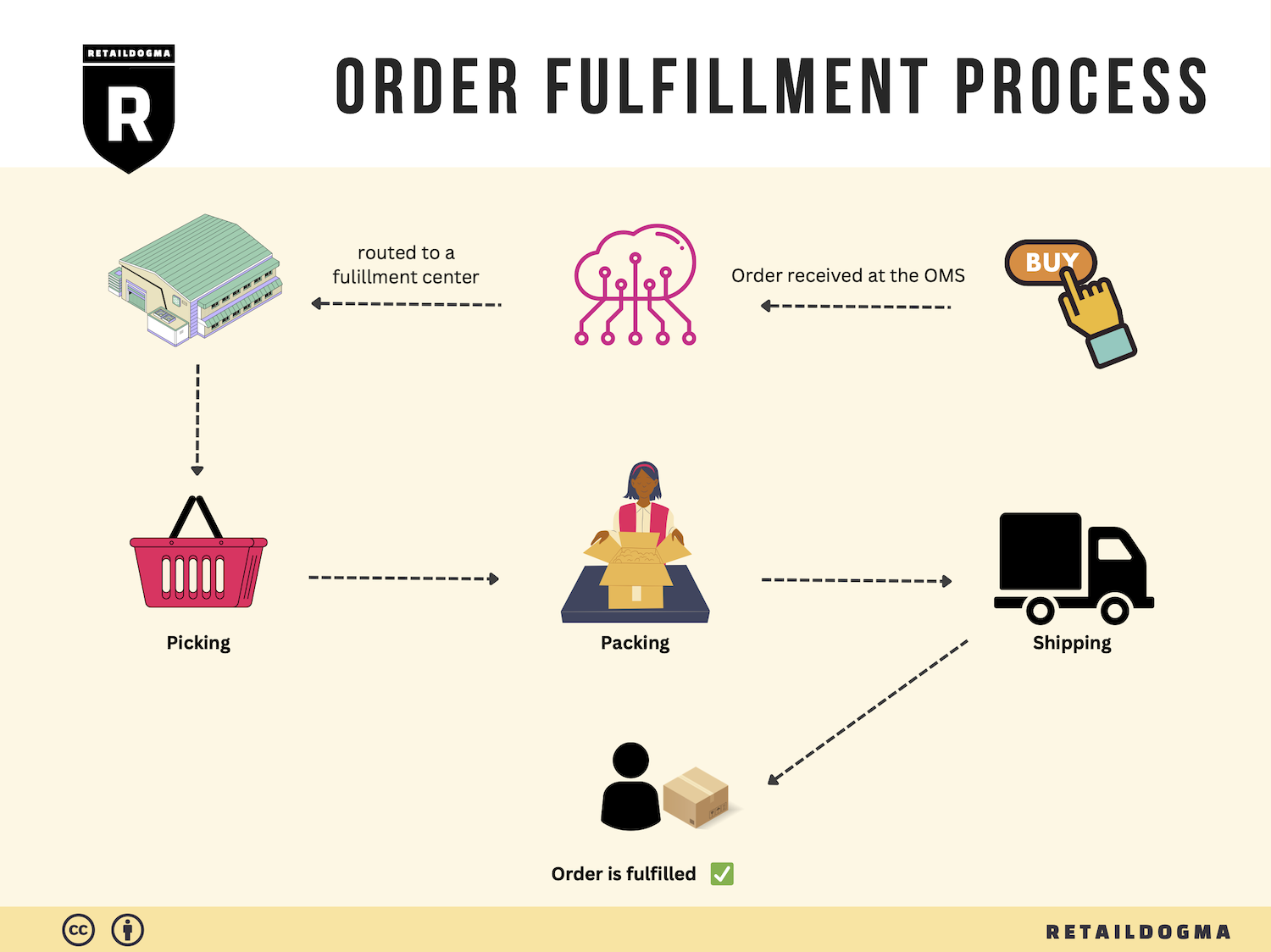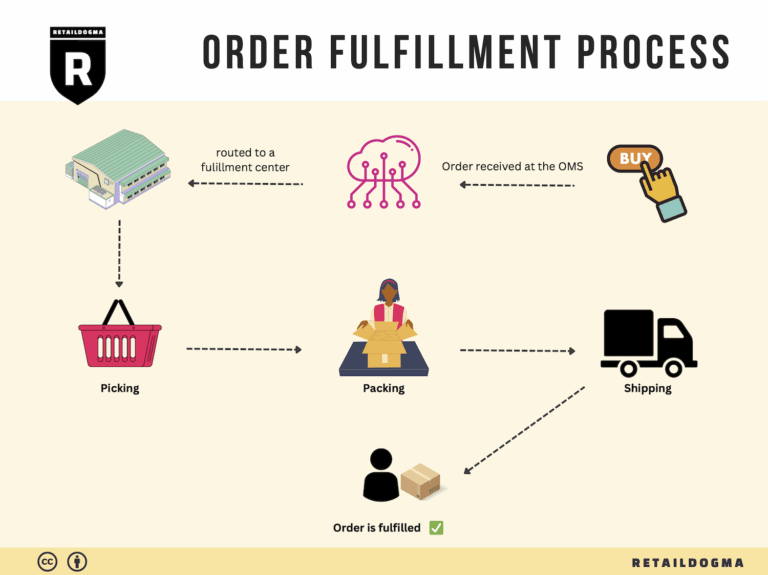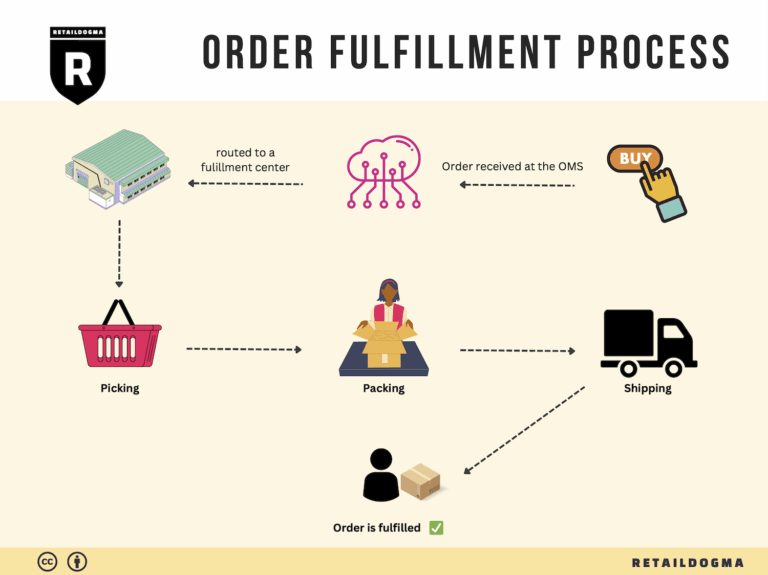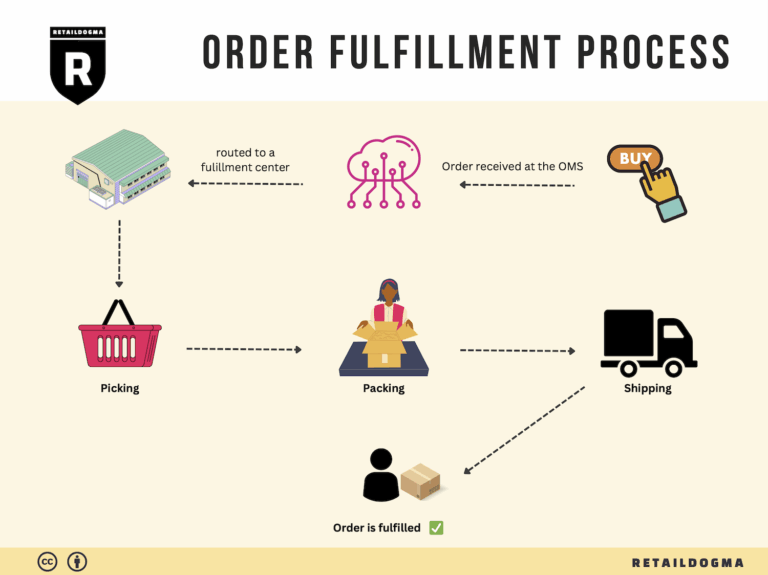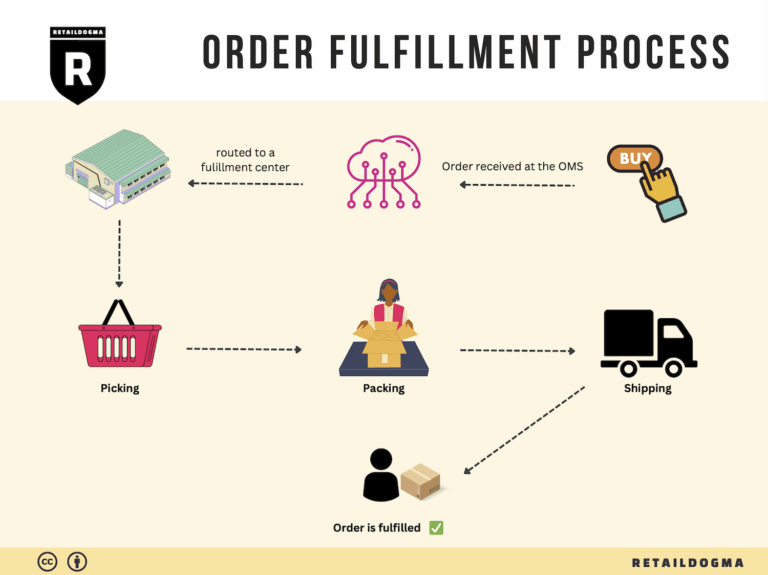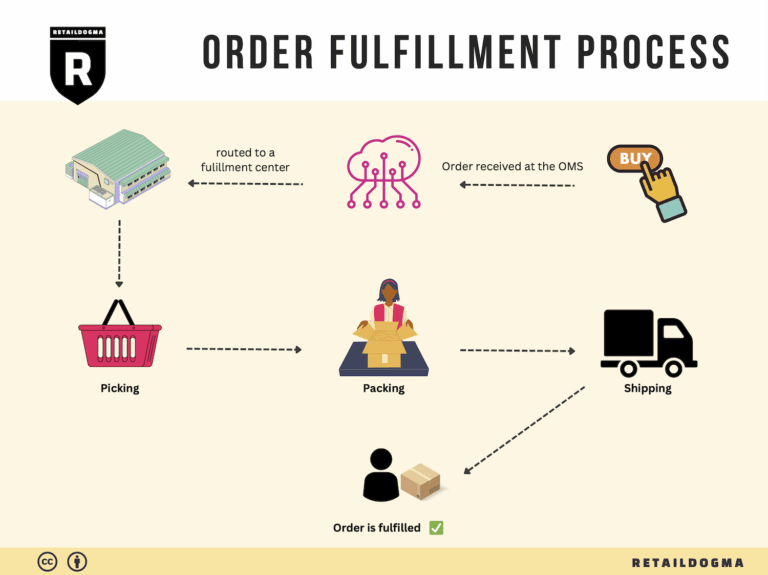What Is A Fulfillment Center? A Complete Guide (2025)
What is E-commerce Fulfillment? An Introduction for Growing Businesses
Understanding E-commerce Fulfillment for Growing Businesses
As an e-commerce business owner, you may find yourself grappling with the complexities of packing and shipping orders. This essential yet often overwhelming aspect of your operations can quickly drain your time and resources, hindering your ability to scale effectively. Fulfillment, in simple terms, is the process of getting a product from your inventory into the hands of your customers. It encompasses everything from receiving and storing inventory to picking, packing, and shipping orders, as well as handling returns.
In this guide, we will delve into the various models of fulfillment available to you, including Third-Party Logistics (3PL) and Fulfillment by Amazon (FBA). Each model offers unique advantages and can significantly impact your operational efficiency. Understanding these options is crucial for making informed decisions that align with your business goals.
We will also explore the core services provided by fulfillment partners, such as inventory management, order processing, shipping logistics, and customer service. These services can either be handled in-house or outsourced, depending on your resources and strategic objectives. Knowing what to look for in a fulfillment partner can save you considerable time and money while ensuring a positive customer experience.
Choosing the right fulfillment partner is a pivotal decision for your business. We will outline key considerations and criteria to help you select a partner that fits your needs, including their technology capabilities, service levels, scalability, and geographical reach. A well-chosen partner can enhance your operational efficiency and allow you to focus on what you do best: growing your business.
Finally, we will discuss pricing models in the fulfillment landscape. Understanding how fulfillment partners charge for their services—whether through flat rates, per-order fees, or variable pricing based on volume—will help you budget effectively and avoid unexpected costs.
The goal of this guide is to empower you with the knowledge necessary to make strategic decisions about your logistics. By understanding the intricacies of e-commerce fulfillment, you can streamline your operations, improve customer satisfaction, and ultimately drive growth in your business. Let’s get started on the path to effective fulfillment and operational excellence!
What You’ll Learn In This Guide
- What is E-commerce Fulfillment? An Introduction for Growing Businesses
- The Order Fulfillment Process: From ‘Buy’ Button to Customer’s Door
- Comparing Fulfillment Models: In-House vs. 3PL vs. Dropshipping
- A Deep Dive into Amazon FBA: Pros, Cons, and Who It’s For
- Core Services Offered by Fulfillment Centers
- How to Choose a Fulfillment Partner: A 6-Point Checklist
- Understanding Fulfillment Pricing: A Breakdown of Common Fees
- Frequently Asked Questions (FAQs) about Fulfillment
- Conclusion: Is Outsourcing Fulfillment the Right Move for Your Business?
- Important Disclaimer
The Order Fulfillment Process: From ‘Buy’ Button to Customer’s Door
1. Receiving Inventory
The order fulfillment process begins with receiving inventory from suppliers or manufacturers. This step involves checking the incoming products against purchase orders to ensure that the correct items and quantities have been delivered. Key personnel are responsible for inspecting the condition of the goods and logging them into the inventory management system.
Importance: Proper inventory receiving is crucial as it sets the foundation for all subsequent steps in the fulfillment process. Errors in this stage can lead to stock discrepancies, delays in order processing, and ultimately, customer dissatisfaction.
Key Term: SKU (Stock Keeping Unit) – A unique identifier assigned to each product, used to track inventory levels and streamline the receiving process.
2. Warehouse Storage
Once inventory is received, it must be stored efficiently within the warehouse. This involves categorizing products and placing them in designated storage locations that optimize space and facilitate easy access. Effective warehouse layout strategies, such as zoning and slotting, are employed to enhance retrieval efficiency.
Importance: Efficient warehouse storage reduces the time it takes to pick orders and minimizes the risk of errors. A well-organized warehouse can significantly impact operational costs, as it streamlines processes and maximizes space utilization.
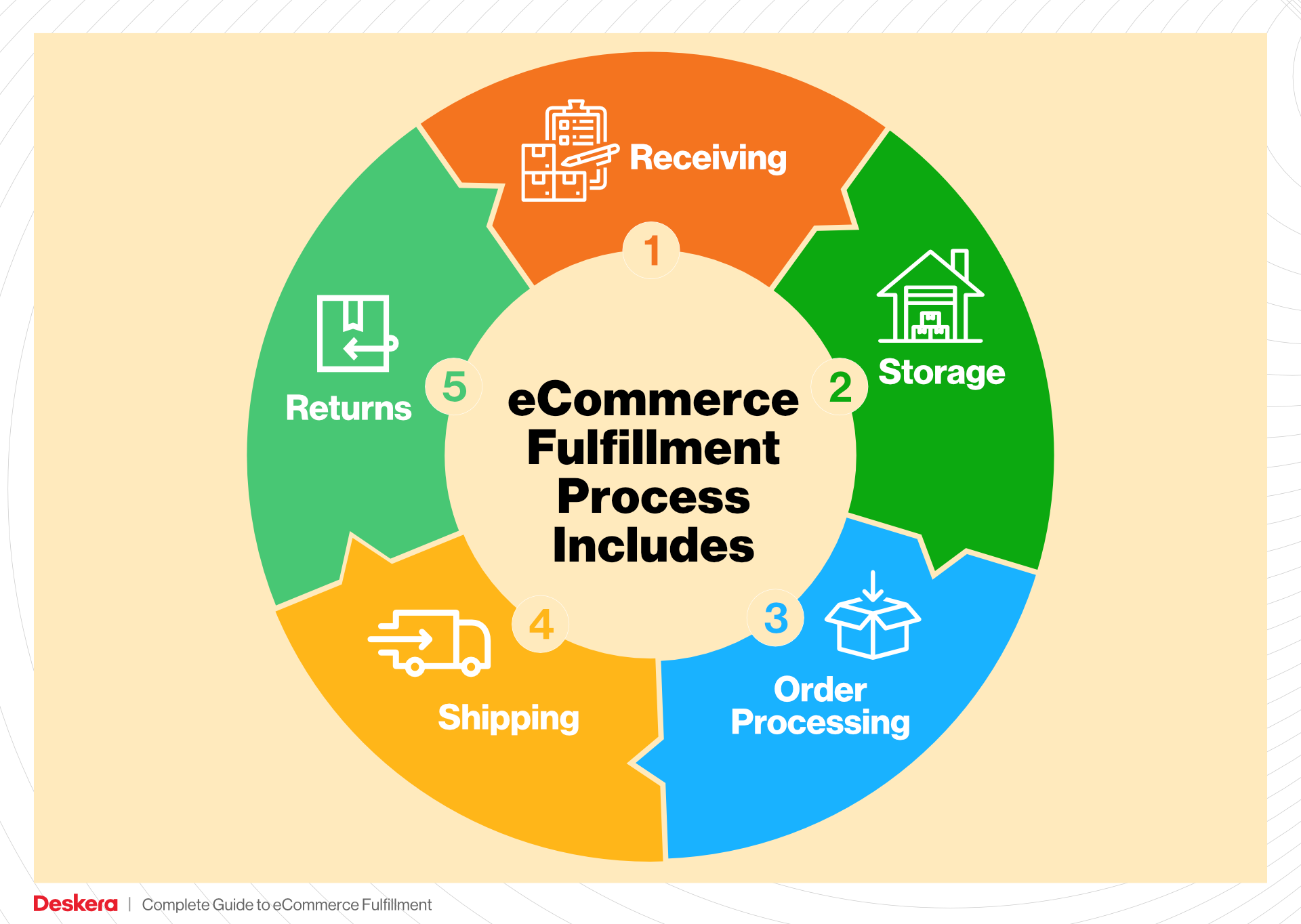
Key Term: ABC Analysis – A method used to categorize inventory based on importance and turnover rate, helping businesses prioritize storage space for high-demand items.
3. Order Picking
When a customer places an order, the next step is order picking, where items are retrieved from their storage locations based on the specifics of the order. Warehouse staff or automated systems utilize pick lists, which detail the items needed for fulfillment, to ensure accuracy and efficiency during this process.
Importance: Order picking is a critical step that directly affects customer satisfaction. Fast and accurate picking ensures that orders are fulfilled correctly and shipped on time, which is essential in today’s competitive e-commerce environment.
Key Term: Pick Lists – Documents or digital records that outline the items to be retrieved for a specific order, helping streamline the picking process.
4. Order Packing
After items are picked, they are moved to the packing station, where they are carefully packaged for shipment. This step involves choosing appropriate packing materials, weighing the package, and printing shipping labels. Additionally, packing slips or invoices may be included to provide customers with order details.
Importance: Effective packing not only protects the items during transit but also enhances the customer experience. Properly packed orders reduce the likelihood of returns due to damage and can improve the perception of the brand.
Key Term: Packing Slip – A document that lists the items included in the shipment, serving as a receipt for the customer and a reference for inventory management.
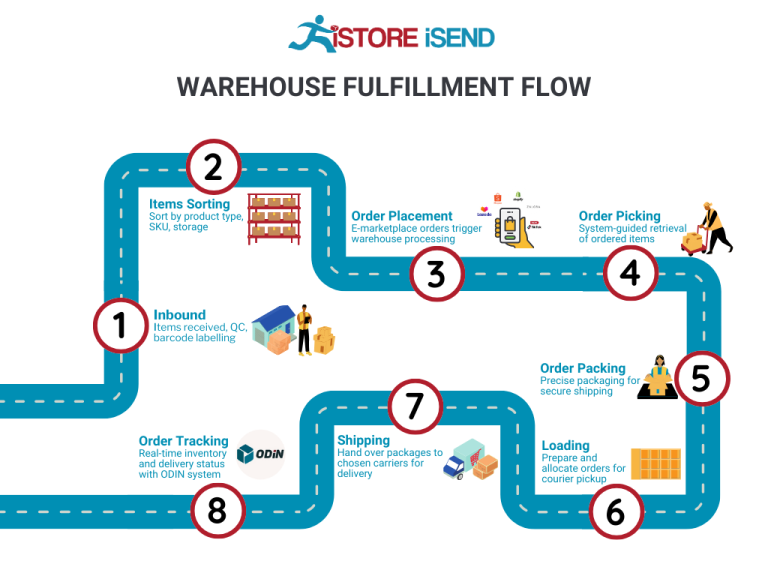
5. Shipping & Delivery
The final step in the order fulfillment process is shipping, where packages are handed over to carriers for delivery to the customer. This stage includes selecting the appropriate shipping method based on factors such as delivery speed, cost, and destination. Tracking information is often provided to customers, allowing them to monitor their order’s journey.
Importance: Timely shipping and delivery are vital for customer satisfaction and retention. In an era where customers expect quick and reliable service, businesses must optimize their shipping strategies to meet or exceed these expectations.
Key Term: Last-Mile Delivery – The final step of the delivery process, where the package is transported from a distribution center to the customer’s doorstep, often considered the most critical and costly part of the shipping process.
By understanding and optimizing each of these five steps in the order fulfillment process, e-commerce businesses can enhance their operational efficiency, reduce costs, and improve overall customer satisfaction, paving the way for scalable growth in a competitive market.
Comparing Fulfillment Models: In-House vs. 3PL vs. Dropshipping
Fulfillment Model Comparison Table
| Model | Who Handles Inventory | Best For (Business Stage) | Key Advantage | Key Disadvantage |
|---|---|---|---|---|
| In-House Fulfillment | The e-commerce business itself | Startups to established businesses | Full control over inventory and processes | High operational costs and resource demands |
| Third-Party Logistics (3PL) | A specialized logistics provider | Growing to established businesses | Scalability and expertise in logistics | Less control over inventory and processes |
| Dropshipping | Suppliers or manufacturers | Startups and niche businesses | Low upfront investment and risk | Lower profit margins and less control over fulfillment quality |
In-House Fulfillment
In-house fulfillment refers to the process where e-commerce businesses manage their inventory, warehousing, and shipping operations directly. This model is often adopted by startups and established businesses that want full control over their logistics and customer experience. One of the primary advantages of in-house fulfillment is the ability to customize operations and respond quickly to customer demands. Businesses can implement tailored packaging, branding, and shipping processes that enhance customer satisfaction. However, this model comes with significant downsides, including high operational costs, the need for substantial investment in warehousing and staff, and the complexity of managing logistics. For companies with limited resources or those just starting, in-house fulfillment may strain finances and distract from core business activities, making it essential to weigh these factors carefully.
Third-Party Logistics (3PL)
Third-party logistics (3PL) involves outsourcing logistics and fulfillment tasks to specialized service providers. This model is particularly well-suited for growing and established businesses that want to scale their operations without the burden of managing logistics themselves. A key advantage of using a 3PL provider is access to their expertise in supply chain management, which can lead to more efficient operations, reduced shipping costs, and improved delivery times. Additionally, 3PL providers often have established networks that can facilitate international shipping and returns management. However, one of the drawbacks is the potential loss of control over inventory and fulfillment processes. Businesses may face challenges in maintaining their brand’s quality standards and customer service expectations when relying on an external partner. Therefore, it’s critical for e-commerce businesses to choose a reputable 3PL provider that aligns with their operational goals and customer service standards.
Dropshipping
Dropshipping is a fulfillment model where the retailer does not keep products in stock but instead transfers customer orders directly to a supplier or manufacturer, who then ships the products directly to the customer. This model is particularly attractive for startups and niche businesses that want to minimize upfront investments and operational risks. One of the significant advantages of dropshipping is the ability to offer a wide range of products without the financial burden of maintaining inventory. This flexibility allows businesses to experiment with various product lines without committing significant capital. However, dropshipping comes with notable disadvantages, such as lower profit margins due to supplier costs and limited control over product quality and shipping times. Additionally, the reliance on third-party suppliers can lead to inconsistent customer experiences, which can harm brand reputation. Entrepreneurs should consider these factors and conduct thorough due diligence on suppliers to mitigate risks associated with dropshipping.
Conclusion
In summary, choosing the right fulfillment model is crucial for e-commerce businesses looking to scale efficiently. Each model—In-House Fulfillment, 3PL, and Dropshipping—offers distinct advantages and challenges that must be carefully considered based on the business stage and operational goals. By understanding these differences, business owners can make informed decisions that align with their growth strategies and customer expectations.
A Deep Dive into Amazon FBA: Pros, Cons, and Who It’s For
Understanding Fulfillment by Amazon (FBA)
Fulfillment by Amazon (FBA) is a service provided by Amazon that enables e-commerce sellers to store their products in Amazon’s fulfillment centers. Amazon then takes care of storage, packaging, shipping, and customer service on behalf of the sellers. By leveraging Amazon’s vast logistics network, sellers can focus on growing their business while Amazon handles the complexities of order fulfillment.
How FBA Works
-
Product Listing: Sellers create product listings on Amazon’s marketplace. When a customer places an order, the product is shipped from Amazon’s fulfillment center.
-
Inventory Storage: Sellers send their inventory to Amazon’s warehouses. Amazon manages the storage and organization of these products.
-
Order Processing: Once an order is placed, Amazon picks, packs, and ships the product directly to the customer. This includes handling returns and customer service inquiries related to those orders.
-
Customer Support: Amazon provides 24/7 customer service for FBA orders, handling inquiries and issues on behalf of the seller.
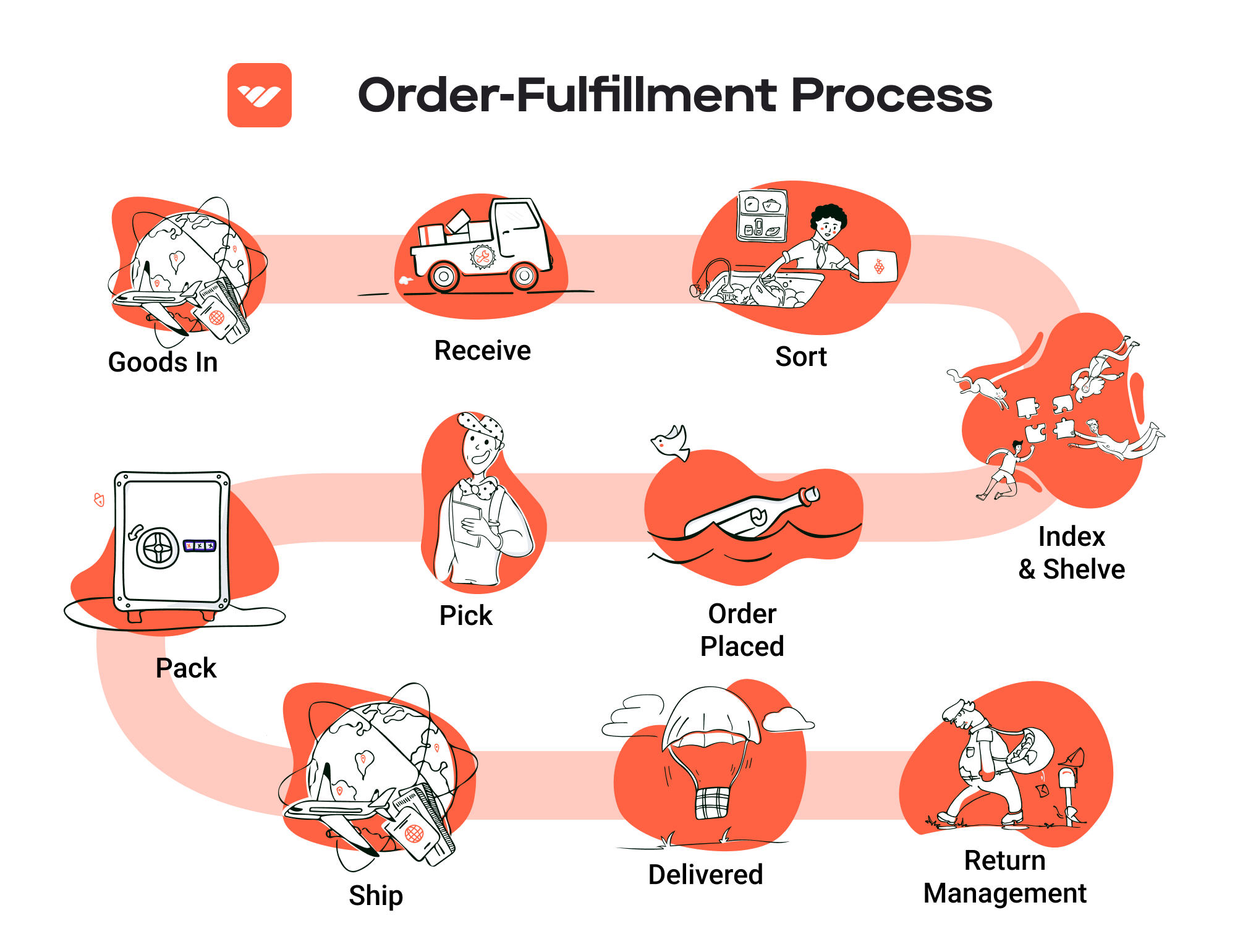
-
Shipping Options: Customers benefit from Amazon’s fast shipping options, including Prime eligibility, which can significantly enhance the attractiveness of the product listing.
Pros of Using FBA
-
Prime Eligibility: Products fulfilled by Amazon are eligible for Amazon Prime, allowing sellers to reach a vast audience of Prime members who are more likely to purchase products with faster shipping options. This can lead to increased sales and higher conversion rates.
-
Customer Trust: Amazon’s reputation for reliability and customer service extends to FBA sellers. Customers are often more willing to buy from sellers using FBA due to the perceived trustworthiness and the quality of service associated with Amazon.
-
Multi-Channel Fulfillment: FBA allows sellers to fulfill orders not only from Amazon’s marketplace but also from their own websites or other sales channels. This flexibility can streamline operations for businesses that sell across multiple platforms.
-
Scalability: FBA enables sellers to scale their business efficiently. As sales increase, sellers can send larger quantities of inventory to Amazon without worrying about the logistical challenges of warehousing and shipping.
-
Time Savings: By outsourcing fulfillment to Amazon, sellers can save considerable time and resources that would otherwise be spent on logistics, allowing them to focus on other aspects of their business, such as marketing and product development.
Cons of Using FBA
-
High Fees: FBA comes with various fees, including storage fees for the products stored in Amazon’s warehouses and fulfillment fees for each unit sold. These costs can add up, particularly for sellers with low margins or slow-moving inventory.
-
Strict Inventory Rules: Amazon has stringent guidelines regarding inventory management. Sellers must ensure that their products comply with Amazon’s policies, which can be time-consuming and challenging, particularly for new sellers.
-
Commingling Risks: Amazon commingles inventory from different sellers, which means that products from various sellers may be stored together. This can lead to issues if a seller receives returns or negative feedback for products that were not theirs, impacting their seller rating.
-
Loss of Control: By using FBA, sellers relinquish control over the fulfillment process. This can lead to challenges in maintaining brand consistency and customer experience, as sellers may not have direct oversight of how their products are handled.
-
Potential for Over-reliance: Businesses that rely heavily on FBA may find themselves vulnerable to changes in Amazon’s policies or fee structures, which can affect profitability and operational stability.
Who is FBA Best For?
Fulfillment by Amazon is particularly advantageous for:
-
Small to Medium-Sized Businesses: Businesses that may not have the resources to manage their own logistics can benefit significantly from FBA, allowing them to leverage Amazon’s extensive infrastructure.
-
E-commerce Entrepreneurs: New sellers looking to enter the market with minimal upfront investment in logistics can find FBA to be a practical solution for getting their products into the hands of customers quickly.
-
Sellers with High-Volume Products: For those who sell products that move quickly and have a higher sales volume, FBA can be an excellent option to streamline fulfillment and take advantage of Amazon’s shipping capabilities.
-
Multi-Channel Sellers: Businesses that sell on multiple platforms can utilize FBA to manage their logistics efficiently across different channels, ensuring that orders are fulfilled promptly regardless of the sales platform.
-
Brands Seeking to Enhance Visibility: Sellers looking to improve their product visibility and sales through Amazon’s Prime program may find that FBA offers a significant competitive edge.
In conclusion, Fulfillment by Amazon provides a powerful avenue for e-commerce businesses to streamline their operations and enhance customer experience. However, it is essential for sellers to weigh the pros and cons carefully and evaluate whether FBA aligns with their business goals and operational capacity.
Core Services Offered by Fulfillment Centers
Inventory Management & Warehousing
Fulfillment centers play a crucial role in inventory management and warehousing by providing businesses with a dedicated space to store their products. This service involves the systematic tracking and organization of inventory levels, enabling e-commerce companies to maintain optimal stock levels without the overhead of managing a warehouse themselves.
One of the primary benefits of utilizing a fulfillment center for inventory management is the reduction of operational costs. Businesses can avoid the expenses associated with leasing or purchasing warehouse space, hiring staff, and maintaining inventory systems. Fulfillment centers often employ advanced inventory management software, which offers real-time data on stock levels, sales trends, and reorder points. This capability allows businesses to make informed decisions regarding inventory replenishment, minimizing the risk of stockouts or overstock situations.
Moreover, fulfillment centers provide scalability for growing e-commerce operations. As sales increase, businesses can easily expand their inventory capacity within the fulfillment center without the need for significant capital investment. This flexibility is particularly beneficial during peak seasons, such as holidays, when demand can fluctuate dramatically.
Pick and Pack Services
Pick and pack services are a cornerstone of fulfillment operations, where items are selected from inventory and packed for shipment to customers. This process involves picking the correct products based on customer orders, packing them securely, and preparing them for dispatch.
The primary advantage of efficient pick and pack services is the speed and accuracy they bring to order fulfillment. Fulfillment centers typically employ trained staff and sophisticated technology, such as barcode scanning and automated sorting systems, to ensure orders are picked accurately and packed efficiently. This not only reduces the likelihood of errors, which can lead to costly returns and dissatisfied customers, but it also enhances overall order processing speed.
For e-commerce businesses, fast and accurate order fulfillment is crucial in maintaining high customer satisfaction and loyalty. In an age where consumers expect quick delivery times, leveraging a fulfillment center’s pick and pack services can significantly improve a business’s competitive edge. Furthermore, many fulfillment centers offer same-day or next-day shipping options, which can enhance the customer experience and encourage repeat purchases.
Kitting and Assembly
Kitting and assembly services involve the pre-assembly of products or the grouping of individual items into ready-to-sell kits. This service is particularly beneficial for businesses that offer products that require assembly before shipping, or that want to provide bundled products at a discounted rate.
The benefits of kitting and assembly services are twofold. First, they streamline the fulfillment process by reducing the amount of time spent on assembly during the order-picking phase. When products are pre-assembled or packaged together, it speeds up the packing process, allowing for quicker turnaround times. This efficiency can be a game-changer for e-commerce businesses looking to enhance their delivery speed and customer satisfaction.
Second, kitting can create additional revenue opportunities for businesses. By offering bundled products, companies can provide customers with perceived value while also increasing average order value. For example, a business selling crafting supplies might offer a kit that includes all necessary items for a specific project, making it easier for customers to purchase everything they need in one go.
Returns Management (Reverse Logistics)
Returns management, often referred to as reverse logistics, is a critical service offered by fulfillment centers that handles the return of products from customers back to the inventory. This service encompasses the entire process of managing returned goods, including inspection, restocking, and processing refunds or exchanges.
An efficient returns management system is vital for e-commerce businesses, as the ease of returning products significantly influences consumer purchasing decisions. Fulfillment centers can streamline the return process, making it simple for customers to return items and ensuring that the returns are processed quickly. This not only enhances customer satisfaction but also helps maintain a positive brand image.
Moreover, effective returns management can contribute to cost savings. By quickly inspecting and restocking returned items, fulfillment centers can minimize losses associated with unsellable inventory. They can also analyze return data to identify patterns or issues with specific products, allowing businesses to make informed decisions regarding quality control and product offerings.
In conclusion, partnering with a fulfillment center for these core services—inventory management and warehousing, pick and pack services, kitting and assembly, and returns management—can provide significant advantages for e-commerce businesses. By leveraging these services, companies can streamline their operations, reduce costs, and enhance customer satisfaction, ultimately enabling them to scale their sales and logistics effectively.
How to Choose a Fulfillment Partner: A 6-Point Checklist
Location & Warehouse Network
The geographical positioning of your fulfillment partner is crucial for ensuring timely deliveries and reducing shipping costs. A partner with a strategically located warehouse network can help you reach your customers more efficiently.
Why It’s Important:
– Shipping Times: Closer warehouses mean faster delivery times, which can enhance customer satisfaction.
– Shipping Costs: Reducing the distance between your products and your customers can lower shipping costs significantly.
Questions to Ask:
1. What is the location of your warehouses, and how do they align with my target market?
2. Can you provide insights into your shipping times for different regions?
3. How do you handle logistics for international shipping?
Technology & Integrations
In today’s digital landscape, the technology used by your fulfillment partner plays a pivotal role in the efficiency of your operations. A robust technology platform enables seamless integration with your e-commerce systems and enhances visibility into your inventory and order statuses.
Why It’s Important:
– Automation: Advanced systems can automate processes, reducing the risk of human error and speeding up fulfillment.
– Real-Time Data: Access to real-time inventory data helps you manage stock levels effectively and avoid stockouts.
Questions to Ask:
1. What fulfillment management software do you use, and how does it integrate with my e-commerce platform?
2. Can you provide real-time tracking for orders and inventory?
3. How do you handle system updates and maintenance?
Specializations (e.g., Cold Storage, Oversized Items)
Different products require different handling methods. If you sell specialized items, such as perishable goods or oversized products, you’ll need a fulfillment partner equipped to manage these specific needs.
Why It’s Important:
– Product Integrity: Proper storage and handling are vital for maintaining product quality, especially for perishables.
– Compliance: Certain products may have regulatory requirements that need to be adhered to during storage and shipping.
Questions to Ask:
1. Do you have specialized facilities for my product types (e.g., cold storage, hazardous materials)?
2. What measures do you take to ensure product quality during storage and transit?
3. Can you handle unique packaging requirements for my products?
Scalability & Capacity
As your business grows, your fulfillment needs will change. Partnering with a fulfillment provider that can scale with your business is essential to avoid interruptions in service.
Why It’s Important:
– Business Growth: A partner that can accommodate increasing order volumes will help you meet customer demand without delays.
– Flexibility: Seasonal fluctuations in demand require a partner that can quickly adjust capacity.
Questions to Ask:
1. What is your current capacity, and how do you plan to accommodate growth?
2. Can you provide additional resources during peak seasons, such as holidays?
3. How do you handle inventory overflow or excess stock?
Pricing and Contracts
Understanding the pricing structure and contract terms of your fulfillment partner is fundamental to maintaining your profit margins. Transparency in pricing helps you avoid unexpected costs and ensures you get value for your investment.
Why It’s Important:
– Budgeting: Clear pricing allows you to plan your budget effectively and avoid surprises.
– Long-Term Viability: Knowing the terms of your contract can help you assess the long-term viability of the partnership.
Questions to Ask:
1. Can you provide a detailed breakdown of your pricing structure, including any hidden fees?
2. What is the length of your contract, and what are the terms for renewal or termination?
3. Do you offer volume discounts or incentives for long-term commitments?
Customer Support & Reviews
Reliable customer support is vital for addressing any issues that may arise during the fulfillment process. Additionally, reviews from other businesses can provide insights into the partner’s reliability and performance.
Why It’s Important:
– Issue Resolution: Prompt and effective customer support can minimize disruptions and keep your operations running smoothly.
– Reputation: Positive reviews can indicate a partner’s commitment to service and reliability.
Questions to Ask:
1. What support channels do you offer (e.g., phone, email, chat), and what are your response times?
2. Can you provide references or case studies from businesses similar to mine?
3. How do you handle disputes or fulfillment errors, and what is your process for resolution?
Conclusion
Choosing the right fulfillment partner is a critical decision that can significantly impact your business’s growth and customer satisfaction. By systematically evaluating potential partners against this checklist, you can ensure that you make an informed choice that aligns with your operational needs and business goals. Always remember to prioritize communication and transparency to foster a successful long-term partnership.
Understanding Fulfillment Pricing: A Breakdown of Common Fees
Initial Setup Fees
When starting with an Amazon fulfillment center, businesses may encounter initial setup fees, which are typically one-time charges associated with onboarding your products into the fulfillment network. These fees can vary based on the complexity of your inventory and the services you require. Common components of initial setup fees include:
- Account Setup: Creating an account with Amazon and configuring your seller profile may incur a nominal fee.
- Inventory Preparation: If your products need special packaging, labeling, or bundling, additional costs may apply for these services.
- Training and Support: Some fulfillment services offer training sessions for your team on how to efficiently manage inventory and orders, which may also be charged.
Understanding these fees upfront can help businesses budget appropriately and avoid unexpected costs as they begin their journey with Amazon’s fulfillment services.
Receiving Fees
Receiving fees are charged for the process of accepting and processing your inventory at the fulfillment center. This fee structure is usually based on the volume of inventory being received and can include:
- Per-Item Fee: A flat fee for each unit received. This is typically calculated per SKU and may vary based on size and weight.
- Complexity Fee: For products that require additional handling, such as those needing inspection, repackaging, or special labeling, a higher fee may be applied.
These fees are crucial to factor into your cost calculations, especially if you anticipate large shipments or have a diverse product range.
Storage Fees (per pallet/bin)
Storage fees are recurring charges that apply to the space your inventory occupies in the fulfillment center. These fees are generally calculated based on:
- Monthly Storage Rate: This is typically charged per cubic foot or per pallet. Amazon often has different rates for standard-size items and oversized items, with the latter costing more due to the additional space they occupy.
- Seasonal Adjustments: During peak seasons, such as holidays, storage fees may increase. Amazon often implements higher rates in Q4 to account for increased demand and limited space.
To optimize your storage costs, consider analyzing your inventory turnover rates and adjusting your stock levels accordingly to minimize excess storage.
Pick & Pack Fees (per item/order)
Pick and pack fees are charges incurred when an order is processed through the fulfillment center. This fee is based on the number of items in each order and typically includes:
- Picking Fee: A fee for each item picked from the shelves. This fee may vary based on the complexity of the order (e.g., a single item versus multiple SKUs).
- Packing Fee: A fee for packaging the picked items for shipment. This fee can also differ based on the packaging materials required for specific products.
These fees can add up quickly, especially for businesses with high order volumes or diverse product lines. Understanding your average order size can help you estimate these costs more accurately.
Shipping Fees
Shipping fees represent the costs associated with delivering your products to customers. These fees can be influenced by several factors, including:
- Destination: Shipping costs will vary depending on the distance from the fulfillment center to the customer’s location.
- Shipping Method: Different shipping options (standard, expedited, same-day) carry different costs, which can significantly impact your overall expenses.
- Package Dimensions and Weight: Heavier and larger packages typically incur higher shipping fees.
To manage shipping costs effectively, leverage Amazon’s shipping calculators and consider using Amazon’s partnered carriers to benefit from discounted rates.
Tips for Getting an Accurate Quote
To ensure you receive an accurate quote for fulfillment services, consider the following strategies:
-
Understand Your Inventory: Provide detailed information about your products, including dimensions, weight, and packaging requirements, to get precise estimates.
-
Estimate Order Volume: Share projected order volumes and seasonal fluctuations with your fulfillment partner to help them provide tailored pricing.
-
Request a Breakdown: Ask for a detailed breakdown of all fees associated with your fulfillment services. This transparency will help you identify potential cost-saving opportunities.
-
Compare Providers: Don’t hesitate to compare quotes from different fulfillment services to ensure you’re getting the best value for your business needs.
-
Negotiate Terms: If you have a high volume of orders, negotiate fees and terms with your fulfillment partner for better pricing.
By being thorough in your inquiry and proactive in your planning, you can navigate fulfillment pricing effectively, ensuring your business scales without unnecessary financial burdens.
Frequently Asked Questions (FAQs) about Fulfillment
1. How do I apply for a position at an Amazon fulfillment center?
To apply for a position at an Amazon fulfillment center, visit the Amazon.jobs website. You can search for available positions based on your preferred location and job category. Once you find a role that interests you, click “Apply Now” to create an account and fill out the application form. Depending on the position, you may need to answer specific questions related to the role and select your preferred shift.
2. What is the difference between a warehouse and a fulfillment center?
A warehouse primarily serves as a storage facility for goods, while a fulfillment center is designed to handle the entire order fulfillment process. This includes receiving inventory, processing orders, picking and packing items, and shipping them to customers. Fulfillment centers are typically more automated and focused on speed and efficiency to meet customer demands.
3. What is a 3PL (Third-Party Logistics)?
A 3PL is a service provider that manages logistics operations for businesses. This includes warehousing, transportation, inventory management, and order fulfillment. By partnering with a 3PL, e-commerce businesses can streamline their operations, reduce costs, and focus on their core competencies without needing to manage logistics in-house.
4. How much do fulfillment services cost?
The cost of fulfillment services can vary widely based on several factors, including the volume of orders, the type of products being shipped, storage space requirements, and the specific services provided (e.g., picking, packing, shipping). It’s essential to obtain quotes from multiple fulfillment providers to compare costs and find a solution that fits your budget and business needs.
5. Do I need a resume to apply for a job at an Amazon fulfillment center?
No, for most positions at Amazon fulfillment centers, you do not need to submit a resume. Instead, you will answer a series of questions during the application process. Make sure to provide accurate and detailed responses to showcase your qualifications.
6. What happens after I submit my application?
After submitting your application, you will receive a confirmation email. Your application will be reviewed, and if your qualifications match the job requirements, you may be contacted for further assessments or interviews. You can also check the status of your application by logging into your Amazon.jobs account.
7. Are there opportunities for career advancement in Amazon fulfillment centers?
Yes, Amazon offers numerous opportunities for career advancement within its fulfillment centers. Employees can benefit from training programs, upskilling initiatives, and the potential to move into management or specialized roles based on performance and experience.
8. Can I apply for a job at a fulfillment center if I need a work permit?
Yes, you can apply for a job at an Amazon fulfillment center if you require a work permit. However, you will need to ensure that you meet all legal requirements and have the necessary documentation to work in your desired location.
9. How does Amazon ensure a safe working environment in fulfillment centers?
Amazon prioritizes employee safety by implementing strict safety protocols, providing training, and utilizing technology to monitor working conditions. Fulfillment centers are equipped with safety equipment, and employees are encouraged to report any unsafe conditions to management.
10. What are the benefits of working at an Amazon fulfillment center?
Working at an Amazon fulfillment center comes with various benefits, including competitive pay, health insurance (medical, dental, and vision), paid time off, retirement plans, and opportunities for career growth. Additionally, Amazon is committed to fostering a diverse and inclusive work environment.
Conclusion: Is Outsourcing Fulfillment the Right Move for Your Business?
Evaluating the Benefits of Outsourcing Fulfillment
Outsourcing fulfillment can be a strategic move for e-commerce businesses looking to scale efficiently. The primary benefits of utilizing a fulfillment service include significant time savings, enhanced scalability, and access to specialized expertise. By outsourcing logistics, you can free up valuable time to focus on core business activities such as marketing, product development, and customer engagement. This shift allows you to allocate resources more effectively, driving overall growth.
Scalability is another critical advantage. As your business grows, so do the complexities of order processing, inventory management, and shipping logistics. A fulfillment partner can seamlessly adjust to fluctuations in demand, whether during peak seasons or unexpected surges in sales. This adaptability ensures you can meet customer expectations without being bogged down by operational challenges.
Moreover, partnering with a fulfillment service grants you access to industry expertise and advanced technology. These partners often have established systems in place to optimize inventory management, streamline shipping processes, and reduce costs. Leveraging their capabilities can lead to improved delivery speeds, higher customer satisfaction, and ultimately, increased sales.
However, it’s essential to choose the right fulfillment partner to support your growth. Conduct thorough research and consider factors such as their track record, technology, customer service, and geographical reach. Aligning your business goals with the right partner can make all the difference.
As a strategic next step, we encourage you to conduct a thorough audit of your current shipping processes. Assess your capacity to scale and identify pain points that may hinder your growth. By evaluating whether a fulfillment partner aligns with your operational needs, you can take informed steps towards optimizing your logistics and positioning your business for success.
Important Disclaimer
⚠️ Important Disclaimer
The information in this guide is for educational purposes. Fulfillment services, pricing, and platform features change frequently. Always conduct your own due diligence and consult with providers directly before making business decisions.
